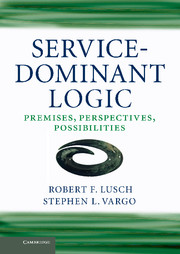Book contents
- Frontmatter
- Dedication
- Contents
- List of Exhibits
- Foreword
- Preface
- Acknowledgments
- Part I Premises
- 1 The service-dominant mindset
- 2 Roots and heritage
- 3 Axioms and foundational premises
- 4 Service as a guiding framework
- Part II Perspectives
- Part III Possibilities
- Appendix Reflection and dialogue
- Index
- References
3 - Axioms and foundational premises
Published online by Cambridge University Press: 05 June 2014
- Frontmatter
- Dedication
- Contents
- List of Exhibits
- Foreword
- Preface
- Acknowledgments
- Part I Premises
- 1 The service-dominant mindset
- 2 Roots and heritage
- 3 Axioms and foundational premises
- 4 Service as a guiding framework
- Part II Perspectives
- Part III Possibilities
- Appendix Reflection and dialogue
- Index
- References
Summary
Production is not the application of tools to materials, but logic to work.
Peter F. DruckerIntroduction
All logics are based on premises and assumptions. Often these are not explicit or spoken but are implicit and unspoken. Logics can be observed in everyday practices and language. In the development of service-dominant (S-D) logic we have attempted to be explicit about its premises, assumptions, and language (or what we call its lexicon).
Four axioms form the foundation of S-D logic, as briefly reviewed in Chapter 1. These four axioms serve as a platform for a half-dozen additional foundational premises that, in addition to the four axioms, form the ten foundational premises (FPs) that comprise the underlying structure of S-D logic. These are illustrated in Exhibit 3.1.
As noted in Exhibit 3.1, under axiom 1 (FP1), “service is the fundamental basis of exchange,” we have four derivative FPs: FP2, “indirect exchange masks the fundamental basis of exchange”; FP3, “goods are distribution mechanisms for service provision”; FP4, “operant resources are the fundamental source of competitive advantage”; FP5, “all economies are service economies.” Under axiom 2 (FP6), “the customer is always a cocreator of value,” there are two derivative FPs: FP7, “the enterprise cannot deliver value, but only offer value propositions; and FP8, “a service-centered view is inherently customer oriented and relational.” Axiom 3 (FP9), “all economic and social actors are resource integrators,” and axiom 4 (FP10), “value is always uniquely and phenomenologically determined by the beneficiary,” stand alone without direct derivative FPs. The structure and the order of the FPs under the four axioms are used primarily for pedagogical purposes. As you become more familiar with the FPs and all of their intricacies you will begin to see how all of the FPs relate to each other but with the four axioms as the most foundational. In brief, six FPs are nested under four axioms.
- Type
- Chapter
- Information
- Service-Dominant LogicPremises, Perspectives, Possibilities, pp. 53 - 82Publisher: Cambridge University PressPrint publication year: 2014

